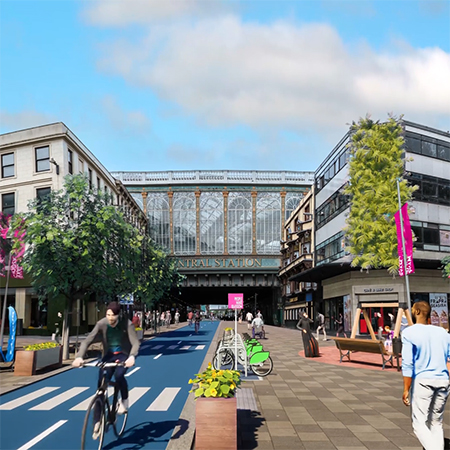Our latest Future Cities transformation is focused on Glasgow. A city with a progressive spirit, its Central Station is a historic symbol of Glasgow's prominence in the Industrial Revolution. In this transformation, we are showing how Central Station can once again be a part of a forward-thinking transport revolution as we present a greener and healthier vision for Glasgow.
The wave of transformation continues
Building on our commitment and progress from our recent Future Cities campaigns in London, Berlin, and Bilbao, we're excited to announce that Glasgow is the second location for this year’s campaign. As awareness spreads about the potential positive impacts of urban cycling, we’re determined to create an inspiring vision of the future where cycling can contribute significantly to citizens' environment, health, and overall well-being.
We use CGI to reimagine our cities, creating visions of how it could appear with less noise and air pollution, and reduced congestion. In this potential future, cities will be appealing and accommodating places with space for people and nature to flourish. Riding the wave of interest generated by Glasgow's hosting of the Cycling World Championships, we found four potential locations ripe for transformation, with the ultimate winner chosen by our followers on social media.
Our site of transformation is Glasgow’s Central Station, a busy transport hub and an architectural icon of the industrial age. Located at the heart of the city, it's a critical junction serving as the northern terminus of the West Coast Main Line. Both tourists and locals alike stream in and out daily, the central position of this historic station makes it a constant thoroughfare for the city.
As an architectural masterpiece inaugurated in 1879, the station exterior reflects Glasgow's Victorian heritage. Its stunning glass-walled train shed and the iconic glass-walled railway bridge are priceless Edwardian-era relics. The railway bridge that carries the platforms of Glasgow Central Station over Argyle Street was nicknamed "Hielanman's Umbrella" (Highland Man) in the 19th century as it was a popular spot for Highlanders to gather. The "umbrella" was named as the bridge provided shelter from the typical West Scotland rain. This spot also became a symbol of home for those Highlanders who were relocated during the clearances, it holds significant social and historical value.
Over the years, the station has been refurbished multiple times, blending modern features with the station’s rich historical essence. In our CGI transformation, we envisage this monumental train station without the constant hum of traffic and with spaces for people to walk and cycle freely, allowing the station's architectural elegance to truly shine.
The future is ours to create
Sometimes people need to see the result to truly know what they have been working towards and to provide their journey with value and purpose. We want this project to be an inspiration, an exciting reimagination where history intertwines with eco-friendly innovation. Glasgow has a special place in our hearts. Our CGI image takes an emblem of the Industrial Revolution and transforms it into a potential beacon of green transformation, where heritage and sustainability harmoniously coexist.
We hope that Future Cities inspires change toward greener, healthier urban living.


Share this article






